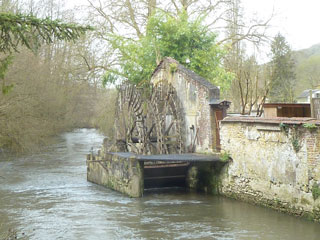Prochain point : lat="49.074143999986816" lon="1.592006"

The Malgrain mill and the factory
The use of hydraulic power
Facilities on the Epte…
In the Middle Ages, mills belonged to the priesthood or the local lord, who had legal control of the waterways and were responsible for the costs of building and maintaining mills. As early as the 12th century, abbeys possessed mills on the Epte and its tributaries. Each fiefdom had a sole communal mill. The inhabitants were obliged to use the communal mills, wine presses and ovens, and to pay feudal duties for the privilege up until the French Revolution.
Although the Malgrain Mill was not a communal mill, in 1712, the owner still had to pay ten livres in rent to the Duke of La Roche-Guyon. The parishioners of Gommecourt were no doubt obliged to use the communal mill in Roconval. Up until the dawn of the 19th century, the facilities on the Epte basin were mainly used to mill wheat. The proximity of the Seine and the Oise as well as the construction of the Paris-Dieppe rail line contributed to the development of manufacturing. Many mills bore witness to the move from traditional to industrial production methods.
…and their various products
At the end of the 19th century, the owner of this mill, Pierre Malgrain, updated the water wheel with the latest technology, so it had a 30 horsepower driving force. The old system of millstones was replaced in 1892 by rolling machines, enabling him to produce very fine quality flour. The mills average daily output was then 50 quintals of flour.
In 1876, a zinc rolling mill was built on a branch of the Epte. The water was retained by a system of valves, opening and lowering as desired. It produced 700,000 kilos of rolled zinc per year. The factory’s driving power and development enabled it to double production. However, the zinc activity slowed, and in oder to keep workers occupied, the head of the mill, Monsieur Labarrière, introduced a section to extract superphosphates from fatty bones in 1884. Subsequently, the factory produced 30,000 quintals of this fertilizer. All activities ceased around 1950.



